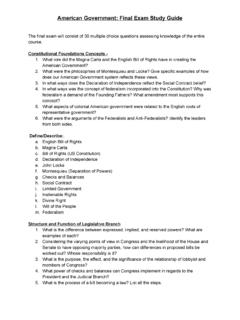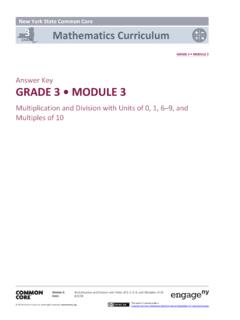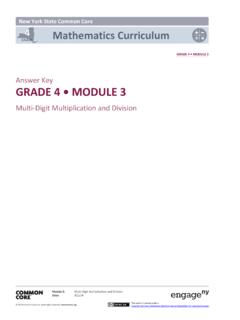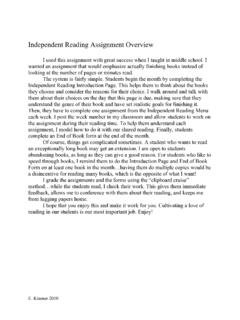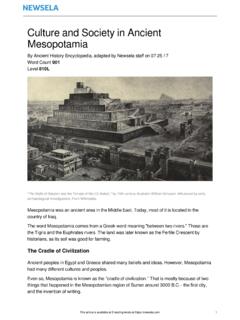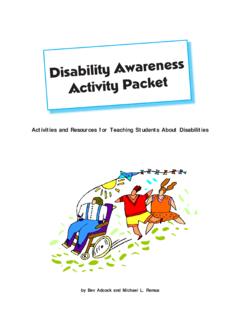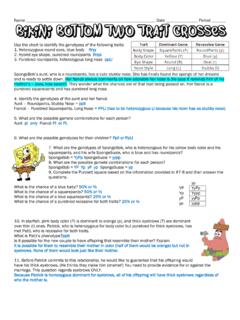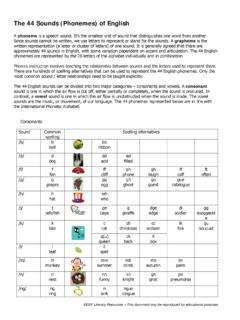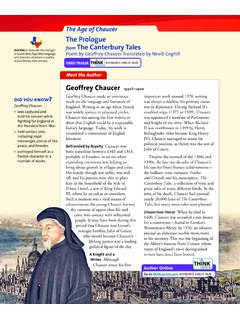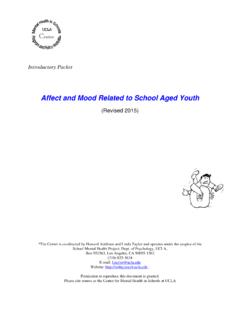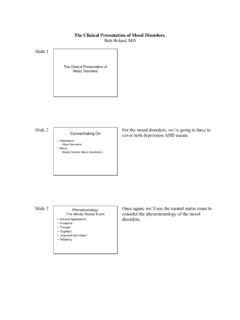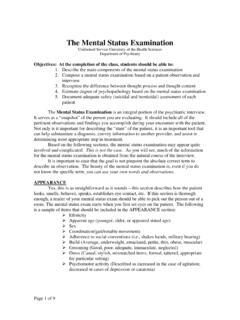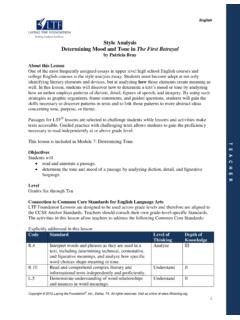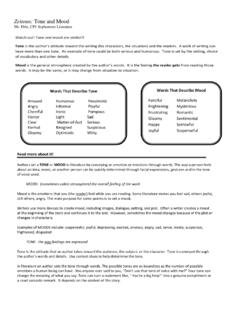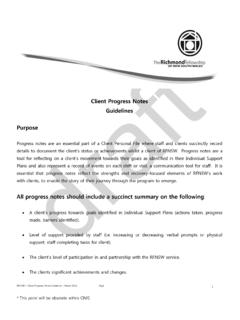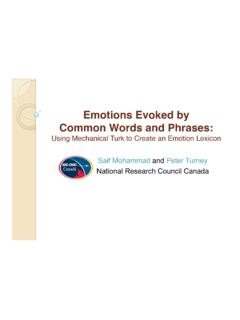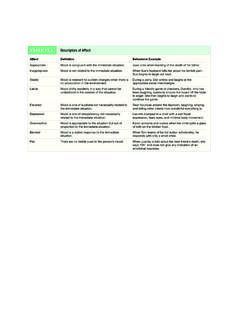Transcription of Close Reading: Analyzing Mood and Tone
1 Close reading : Analyzing mood and Tone Pre-AP and AP English Tone refers to the attitude an author displays toward her subject or audience. mood refers to the audience s feeling toward the subject of the writing. Authors work hard to create specific tones and moods in their writing, and the job of a careful reader is to hear the tone and mood not just to read the words on the page. Tone and mood are often subtle. Since we can t literally hear the author s voice, we must infer her tone and mood from evidence in her writing. reading this way requires careful attention to every choice an author makes; hence, it is called Close reading . To infer the tone of a piece of literature, we will need to recognize and explain how the author uses each of the following elements: diction, imagery, details, language, and syntax.
2 These elements are known, for short, as DIDLS. Diction refers to the author s choice of words and phrases. Imagery is a sensory perception created by the author s words . Details are small, specific facts that the author chooses to include or omit. Language refers to the register and the style of the author s writing. It also refers to the emotional distance between the author and the subject or the author and the audience. Syntax is the structure and organization of individual sentences and the piece as a whole. The next few pages provide a more exhaustive discussion of each of these elements how authors use them and how you can recognize their intended effect.
3 Relevant Terms from the AP English Exam: literary techniques elements of style (or stylistic elements) resources of language rhetorical strategies rhetorical techniques literary devices Sample question from an AP English Exam: Read the passage. Write an essay in which you analyze how the author uses rhetorical techniques to convey his attitude toward his son s new situation. DIDLS Tone, mood , and the Rhetorical Triangle Pre-AP and AP English Use the rhetorical triangle to illustrate the difference between tone and mood . Write these two words in different places on the triangle, and be prepared to defend your decision. (TRANSPARENCY) Speaker Audience Purpose or Subject Keeping a Dialectical Journal Pre-AP and AP English The purpose of keeping a dialectical journal is to practice reading literature closely and rationally.
4 You ought to strive to include only the most significant textual evidence and provide only the most insightful commentary. Set high standards for yourself. Your journal should represent your best thinking about the literature you are reading . Admittedly, this discipline seems vague and elusive at first. It can be difficult to know whether a word or sentence from the text is really worth commenting on and whether or not your commentary is really insightful or rational. If you find yourself floundering amid these doubts, then it might be helpful for you to follow these steps. 1. Select only the key words and phrases ones that reveal something significant about the author, the subject, or the audience.
5 (Write these words in the left column of your journal.) 2. Pay attention to the context and the subject of each of the words you choose. Ask yourself, a. What is the author referring to? and b. What else is happening before and after this particular word or phrase? 3. Categorize the evidence you have gathered. Group words and phrases by meaning, by effect, by context, or by some other criterion you establish. This categorization will help later when you write your commentary and, eventually, your essay. 4. Comment on your evidence by using the rhetorical triangle. Ask yourself, a. What is the author revealing about himself (or the speaker)? or b. What is the author revealing about the subject?
6 Or c. What is the author revealing about his intended audience? 5. Always include commentary on the author s purpose. Discuss whether or not the author is achieving his intended purpose, and why. (If possible, comment on the tone that the author reveals or the mood that he creates.) Diction Pre-AP and AP English Professional writers choose words deliberately. No word is accidental. When you analyze a writer s diction, you are explaining why she chose the words that she did, knowing that she had thousands of other words to choose from. When Analyzing the purpose or effect of diction, ask the following questions: 1. Is there any difference between the denotative meaning (simple, literal definition) and the connotative meaning (contextual, suggestive meaning) of the words ?
7 If so, what is the difference? 2. Are the words concrete (physical, tangible) or abstract (emotional, intangible, philosophical)? 3. What is the level of formality? Are the words formal, informal, conversational, colloquial? 4. What do the words reveal about the age of the author or the historical context of the piece? Are the words old-fashioned? Common? Trendy? (Would the author s original audience agree with your assessment?) 5. Do the words exhibit local color ( regional dialect), or are they standard and universal? 6. How do the words sound? Are they euphonious (pleasant sounding) or cacophonous (harsh sounding)? 7. Are the words monosyllabic (one syllable) or polysyllabic (more than one syllable)?
8 As always, make sure that you explain why your observations are significant: what they reveal about the author, the audience, the subject, or the purpose of the piece. words you can use to describe an author s diction: denotative connotative concrete abstract formal informal/conversational/colloquial old-fashioned trendy local universal euphonious cacophonous monosyllabic polysyllabic Imagery Pre-AP and AP English The purpose of imagery is to engage the reader s senses in creating a mood or tone. An author might do this in one of two ways. First, he might provide descriptions of sights, sounds, tastes, smells, and feelings to help the reader to experience these sensations with him.
9 Or, second, he might use figures of speech or sound devices to create pleasant, harsh, or otherwise suggestive sensations in the reader s mind. When Analyzing the purpose or effect of imagery, ask the following questions. 1. If Analyzing a description, ask: a. Is the description vivid and clear or vague and ambiguous? What makes it so? b. What implied associations (feelings, experiences) does the description conjure? c. How do the author s choices (details and diction, for example) contribute to the overall effectiveness of the description? 2. If Analyzing figurative language, ask: a. What image or association does the author create? Is the comparison clever, innovative, archetypal, or trite?
10 B. What other associations might this comparison conjure in the audience s mind? What feelings might it create, and why? 3. If Analyzing sound devices, ask: a. What sound is being emphasized? Is it a vowel, a consonant, or a whole syllable? b. What might this sound represent? An object? A process? A feeling? c. Is the sound cacophonous or euphonious? Why would the author want it to be so? Figures of speech commonly used to create imagery: simile direct comparison of unlike things, usually using like or as metaphor direct comparison of unlike things that assumes that one is the other synecdoche metaphor in which a part of a thing represents the whole or vice versa metonymy metaphor in which a word is exchanged for another word closely related to it hyperbole deliberate exaggeration for effect understatement deliberate downplaying for effect personification attributing human qualities to inhuman objects pun play on words .
